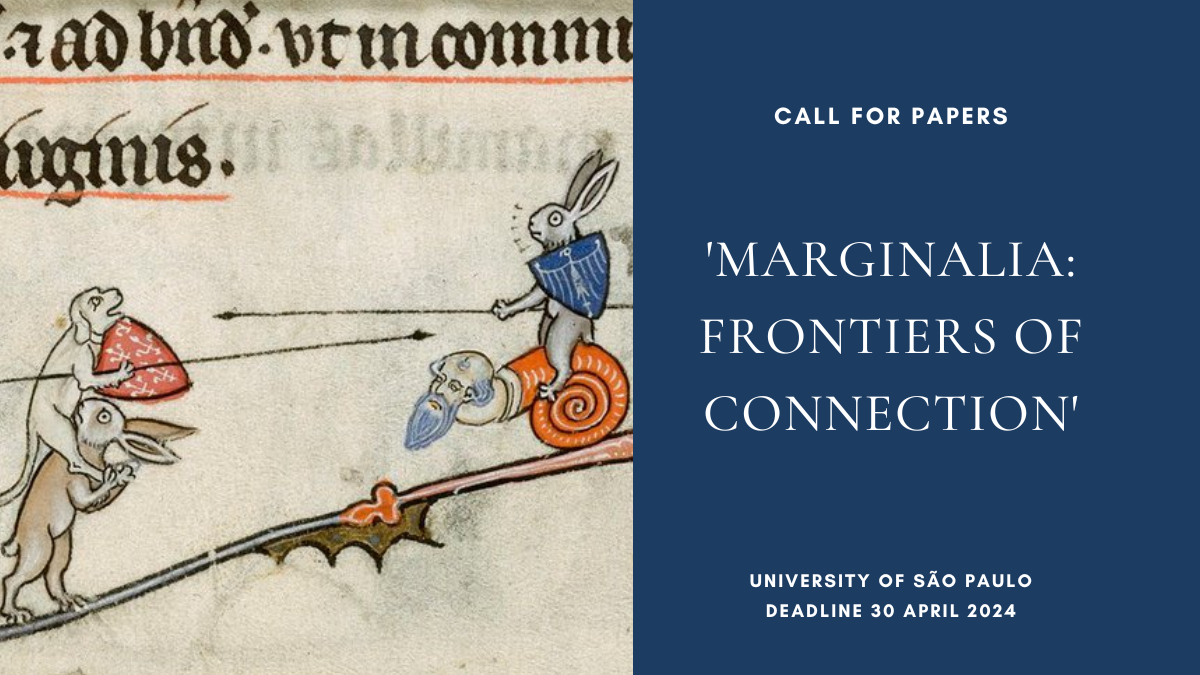XIV International Seminar, The Medieval Image: History and Theory
7-9 August 2024, University of São Paulo
Margins are not mere blank spaces: they can bear various marks of the actions of manuscript producers and consumers. In them, for example, the colouration of the parchment becomes more evident, and sometimes holes for ruled lines can be seen. More importantly, annotations and images of various kinds may have been included there. The margins thus could function as spaces of multiple exchanges both within and outside of the book.
However, margins are not exclusive to manuscripts: they can be physical spaces on a geographical scale or in an architectural sense, as well as symbolic spaces. Travelers, the hungry, prostitutes, lepers, and other marginalised individuals inhabit the margins of the city, not only subverting social norms [1] but also reinventing them, becoming vehicles for the circulation of cultural practices between the center and the periphery and among different peripheral regions. They constituted spaces for the production of counter-hegemonic discourses and resistance [2], while simultaneously producing, disputing, and defining the center as a “social field” [3]. As borders of connection, margins were the first territory to be reached by famine, epidemics, outsiders, and commercial exchanges. It was the space where intentional marginalised individuals – such as the pauperes Christi – could build connections with unintentional marginalised individuals – such as the pauperes inviti.
[1] HOOKS, Bell. Choosing the margin as a space of radical openness. Framework: The Journal of Cinema and Media, n. 36, p. 15-23, 1989.
[2] BOURDIEU, Pierre. Razões práticas: sobre a teoria da ação. São Paulo: Papirus, 1996.
[3] SCHMITT, Jean-Claude. A história dos marginais. In: LE GOFF, Jacques. A História Nova. São Paulo: Martins Fontes, 1990. p. 261-290.
Aim of the conference
The Conference “Marginalia, Frontiers of Connection” aims to be, through the study of images and their modes of production in the Middle Ages, a space for discussion about margins and marginality as connected frontiers. The event will welcome papers that analyze strategies of connection between center/periphery and among different peripheral spaces, as well as the center-margin dichotomy. The fundamental question to be addressed is: How did the margins both produce and reveal spaces of connection in the Middle Ages?
Call for Paper Submission instructions
Paper proposals must be submitted to the email lathimm.usp@gmail.com by April 30th, 2024. Written as expanded abstracts, they are to be published in a specific booklet, having to include a title, a summary of 5,000-7,000 characters (with spaces), 3 keywords, an indication of 4 essential bibliographic references, and the intended axis for the presentation.
Presentations can be delivered in Portuguese, English, or Spanish. The minimum academic level required for paper submissions is to be a Master’s graduate student.
Based on a specific or comparative case study, all presentations should aim to answer the same question: How did the margins produce spaces of connection in the Middle Ages? Presentations will be arranged into three axes, as detailed below:
MARGINAL TERRITORY: the margin as space
- Marginal regions on maps or georeferencing data in digital maps.
- Manuscript margins as spaces of creativity or interaction with center-page contents or other works. Studies on illuminations, ornamented margins, glosses, or doodles.
- Frames, binding, and/or architectural features with supportive functions and their interactions with the image.
- Images of travelers, modes of transportation, informal trade, and commercial routes in spaces of marginality.
MARGINAL NONCONFORMITY: the margin as strangeness
- Marginal/dissident iconographies. Survivals of Antiquity in the Middle Ages.
- Images of marginalized groups: sick or disabled individuals, gender and sexual minorities, prostitutes, drunkards, wanderers, the poor, the famished, charitable institutions, or of voluntary poverty.
- Tools, practices and evidence regarding fixing material defects in image production (cuts, holes, scars, etc.).
MARGINAL SUBVERSION: the margin as dispute
- Images of groups in dispute against hegemonic powers: enslaved individuals, minorities, and political oppositions. Heretical movements, religious disputes, criminalities, and the justice system.
- Images and revisions/notes in manuscripts supplementing/altering the content of the center of the page.
- Graffiti, iconoclasms, scrapings, erasures subverting the content of the text/image.
Schedule
- Proposal submission until April 30th, 2024.
- Announcement of approved submissions and program details by May 10th, 2024.
- Publication of the abstract booklet by July 31st, 2024.
- Event to be held from August 7th to 9th, 2024.
PARTICIPATION MODALITIES
The event will take place in person at the Nicolau Sevcenko Auditorium – Department of History – FFLCH, USP, São Paulo. In-person attendance is mandatory for researchers in Brazil. Remote participation will be allowed only for researchers in other countries. Questions, clarifications, and requests for remote participation should be sent to the email lathimm.usp@gmail.com.
ORGANISATION
- Laboratory of Theory and History of Medieval Media (LATHIMM-USP).
- Thematic Project “A Connected History of the Middle Ages: Communication and Circulation from the Mediterranean Sea” (FAPESP 21/02912-3).
- Supplementary aide:
- Faculty of Philosophy, Letters, and Human Sciences, University of São Paulo
